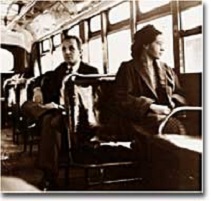54b. Rosa Parks and the Montgomery Bus Boycott

Rosa Parks rode at the front of a Montgomery, Alabama, bus on the day the Supreme Court's ban on segregation of the city's buses took effect. A year earlier, she had been arrested for refusing to give up her seat on a bus.
On a cold December evening in 1955, Rosa Parks quietly incited a revolution — by just sitting down.
She was tired after spending the day at work as a department store seamstress. She stepped onto the bus for the ride home and sat in the fifth row — the first row of the "Colored Section."
In Montgomery, Alabama, when a bus became full, the seats nearer the front were given to white passengers.
Montgomery bus driver James Blake ordered Parks and three other African Americans seated nearby to move ("Move y'all, I want those two seats,") to the back of the bus.
Three riders complied; Parks did not.
The following excerpt of what happened next is from Douglas Brinkley's 2000 Rosa Park's biography.
|
"Are you going to stand up?" the driver demanded. Rosa Parks looked straight at him and said: "No." Flustered, and not quite sure what to do, Blake retorted, "Well, I'm going to have you arrested." And Parks, still sitting next to the window, replied softly, "You may do that." | ||
After Parks refused to move, she was arrested and fined $10. The chain of events triggered by her arrest changed the United States.
King, Abernathy, Boycott, and the SCLC

Martin Luther King Jr. was the first president of the Mongomery Improvement Association, which organized the Montgomery bus boycott of 1955. This began a chain reaction of similar boycotts throughout the South. In 1956, the Supreme Court voted to end segregated busing.
In 1955, a little-known minister named Martin Luther King Jr. led the Dexter Avenue Baptist Church in Montgomery.

Henry David Thoreau's work "Civil Disobedience" provided inspiration for many leaders of the Civil Rights Movement.
King studied the writings and practices of Henry David Thoreau and Mohandas Gandhi. Their teaching advocated civil disobedience and nonviolent resistance to social injustice.
A staunch devotee of nonviolence, King and his colleague Ralph Abernathy were a part of a community organization, the MONTGOMERY IMPROVEMENT ASSOCIATION (MIA), which organized a boycott of Montgomery's buses.
The demands they made were simple: Black passengers should be treated with courtesy. Seating should be allotted on a first-come-first-serve basis, with white passengers sitting from front to back and black passengers sitting from back to front. And African American drivers should drive routes that primarily serviced African Americans. On Monday, December 5, 1955 the boycott went into effect.
Don't Ride the Bus
In 1955, the Women's Political Council issued a leaflet calling for a boycott of Montgomery buses.
Don't ride the bus to work, to town, to school, or any place Monday, December 5.
Another Negro Woman has been arrested and put in jail because she refused to give up her bus seat.
Don't ride the buses to work to town, to school, or any where on Monday. If you work, take a cab, or share a ride, or walk.
Come to a mass meeting, Monday at 7:00 P.M. at the Holt Street Baptist Church for further instruction.
Montgomery officials stopped at nothing in attempting to sabotage the boycott. King and Abernathy were arrested. Violence began during the action and continued after its conclusion. Four churches — as well as the homes of King and Abernathy — were bombed. But the boycott continued.

Together with Martin Luther King Jr., Ralph Abernathy (shown here) organized the Southern Christian Leadership Conference and helped lead the nonviolent struggle to overturn Jim Crow laws.
The MIA had hoped for a 50 percent support rate among African Americans. To their surprise and delight, 99 percent of the city's African Americans refused to ride the buses. People walked to work or rode their bikes, and carpools were established to help the elderly. The bus company suffered thousands of dollars in lost revenue.
Finally, on November 23, 1956, the Supreme Court ruled in favor of the MIA. Segregated busing was declared unconstitutional. City officials reluctantly agreed to comply with the Court Ruling. The black community of Montgomery had held firm in their resolve.
The Montgomery bus boycott triggered a firestorm in the South. Across the region, blacks resisted "moving to the back of the bus." Similar actions flared up in other cities. The boycott put Martin Luther King Jr. in the national spotlight. He became the acknowledged leader of the nascent Civil Rights Movement.
With Ralph Abernathy, King formed the Southern Christian Leadership Conference (SCLC).
This organization was dedicated to fighting Jim Crow segregation. African Americans boldly declared to the rest of the country that their movement would be peaceful, organized, and determined.
To modern eyes, getting a seat on a bus may not seem like a great feat. But in 1955, sitting down marked the first step in a revolution.






